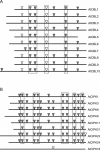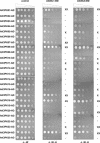Calcium sensors and their interacting protein kinases: genomics of the Arabidopsis and rice CBL-CIPK signaling networks
- PMID: 14730064
- PMCID: PMC316286
- DOI: 10.1104/pp.103.033068
Calcium sensors and their interacting protein kinases: genomics of the Arabidopsis and rice CBL-CIPK signaling networks
Expression of concern in
-
Expression of Concern: Calcium Sensors and Their Interacting Protein Kinases: Genomics of the Arabidopsis and Rice CBL-CIPK Signaling Networks.Plant Physiol. 2024 Jul 31;195(4):3139. doi: 10.1093/plphys/kiae240. Plant Physiol. 2024. PMID: 38739113 Free PMC article. No abstract available.
Abstract
Calcium signals mediate a multitude of plant responses to external stimuli and regulate a wide range of physiological processes. Calcium-binding proteins, like calcineurin B-like (CBL) proteins, represent important relays in plant calcium signaling. These proteins form a complex network with their target kinases being the CBL-interacting protein kinases (CIPKs). Here, we present a comparative genomics analysis of the full complement of CBLs and CIPKs in Arabidopsis and rice (Oryza sativa). We confirm the expression and transcript composition of the 10 CBLs and 25 CIPKs encoded in the Arabidopsis genome. Our identification of 10 CBLs and 30 CIPKs from rice indicates a similar complexity of this signaling network in both species. An analysis of the genomic evolution suggests that the extant number of gene family members largely results from segmental duplications. A phylogenetic comparison of protein sequences and intron positions indicates an early diversification of separate branches within both gene families. These branches may represent proteins with different functions. Protein interaction analyses and expression studies of closely related family members suggest that even recently duplicated representatives may fulfill different functions. This work provides a basis for a defined further functional dissection of this important plant-specific signaling system.
Figures








References
-
- Albrecht V, Weinl S, Balzevic D, D'Angelo C, Batistic O, Kolukisaouglu Ü, Bock R, Schulz B, Harter K, Kudla J (2003) The calcium sensor CBL1 integrates plant responses to abiotic stresses. Plant J 36: 457-470 - PubMed
-
- Allen GJ, Schroeder JI (2001) Combining genetics and cell biology to crack the code of plant cell calcium signaling. Sci Signal Transduction Knowledge Environment 2001: RE13 - PubMed
-
- Altschul SF, Gish W, Miller W, Myers EW, Lipman DJ (1990) Basic local alignment search tool. J Mol Biol 215: 403-410 - PubMed
Publication types
MeSH terms
Substances
LinkOut - more resources
Full Text Sources
Other Literature Sources
Molecular Biology Databases
Miscellaneous

